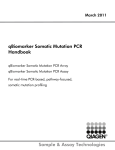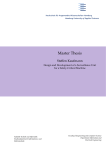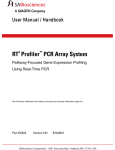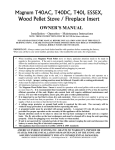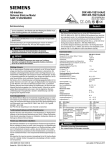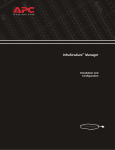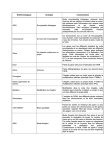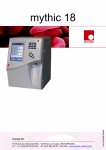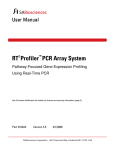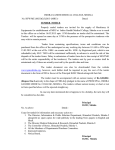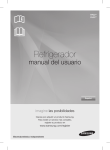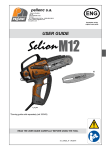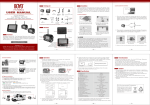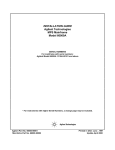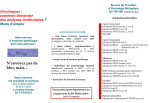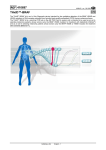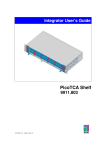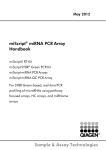Download qBiomarker Somatic Mutation PCR Array System
Transcript
August 2012 qBiomarker Somatic Mutation PCR Handbook qBiomarker Somatic Mutation PCR Array qBiomarker Somatic Mutation PCR Assay For real-time PCR-based, pathway- or disease-focused somatic mutation profiling Sample & Assay Technologies QIAGEN Sample and Assay Technologies QIAGEN is the leading provider of innovative sample and assay technologies, enabling the isolation and detection of contents of any biological sample. Our advanced, high-quality products and services ensure success from sample to result. QIAGEN sets standards in: Purification of DNA, RNA, and proteins Nucleic acid and protein assays microRNA research and RNAi Automation of sample and assay technologies Our mission is to enable you to achieve outstanding success and breakthroughs. For more information, visit www.qiagen.com. Contents Kit Contents 5 Shipping and Storage 7 Intended Use 7 Product Warranty and Satisfaction Guarantee 7 Technical Assistance 7 Safety Information 8 Quality Control 8 Introduction 9 Principle 9 qBiomarker Somatic Mutation PCR Arrays 10 qBiomarker Probe Mastermix 11 Procedure 11 qBiomarker Somatic Mutation PCR Array plate layout 12 Controls 14 Equipment and Reagents to Be Supplied by User 15 Important Notes 16 General precautions 16 DNA purification 16 PCR setup 17 Data analysis 17 Protocols Real-Time PCR Using the qBiomarker Somatic Mutation PCR Array A, C, D, and F Formats 18 Real-Time PCR Using the qBiomarker Somatic Mutation PCR Array E and G Formats 22 Real-Time PCR Using the qBiomarker Somatic Mutation PCR Array E and G Formats 384HT Option 29 Real-Time PCR Using the qBiomarker Somatic Mutation PCR Array R Format 33 Real-Time PCR Using the qBiomarker Somatic Mutation PCR Assay 37 Troubleshooting Guide 41 Appendix A: Whole Genome Amplification of Genomic DNA 43 qBiomarker Somatic Mutation PCR Handbook 08/2012 3 Appendix B: Data Analysis 45 Appendix C: Quality Control Using the qBiomarker Somatic Mutation PCR Array Human DNA QC Plate 47 Appendix D: qBiomarker Somatic Mutation Control DNA 53 References 56 Ordering Information 57 4 qBiomarker Somatic Mutation PCR Handbook 08/2012 Kit Contents qBiomarker Somatic Mutation PCR Arrays Catalog no. 337021 Format A C D E F G R 96-well plate containing dried assays 1 1 1 – 1 – – 384-well plate containing dried assays – – – 1 – 1 – Rotor-Disc® 100 containing dried assays – – – – – – 1 12 – 12 – – – – Optical Adhesive Film (1 per plate – 1 – 1 1 1 Rotor-Disc Heat Sealing Film (1 per Rotor-Disc) – – – – – – 1 384EZLoad Covers* (1 set of 4 per plate) – – – 1 – 1 – qBiomarker Probe Mastermix (tube)† 1 1 1 2 1 2 1 Handbook 1 1 1 1 1 1 1 Optical Thin-Wall 8-Cap Strips (12 per plate) * Must be purchased separately for custom arrays; for single use only † qBiomarker Probe Mastermix is available with ROX™ or fluorescein passive reference dye qBiomarker Somatic Mutation PCR Assay Catalog no. Number of samples (100) 337011 100 qBiomarker Somatic Mutation PCR Assay 1 qBiomarker Somatic Mutation PCR Reference Assay 1 qBiomarker Probe Mastermix 2 Handbook 1 qBiomarker Somatic Mutation PCR Handbook 08/2012 5 Cyclers for use with array formats Format Suitable real-time cyclers Plate A Applied Biosystems® (Standard 96-well block) 5700, 96-well 7000, 7300, 7500, 7900HT, ViiA™ 7; Bio-Rad® Chromo4™, iCycler®, iQ™5, MyiQ™, MyiQ2; Eppendorf® Mastercycler® ep realplex 2, 2S, 4, 4S; Agilent® Mx3005P®, Mx3000P® C Applied Biosystems (Fast 96-well block) 7500 Fast, 7900HT Fast, StepOnePlus™, ViiA 7 Fast 96-well D Bio-Rad CFX96™, Opticon®, Opticon 2; Agilent Mx4000® 96-well E Applied Biosystems (384-well block) 7900HT (384well block), ViiA 7; Bio-Rad CFX384™ 384-well F Roche® LightCycler® 480 (96-well block) 96-well G Roche LightCycler 480 (384-well block) 384-well R QIAGEN Rotor-Gene® cyclers Rotor-Disc 100 Note: qBiomarker Somatic Mutation PCR Arrays cannot be used with the Cepheid SmartCycler® or the Roche LightCycler 2.0. Cyclers compatible with ROX or fluorescein reference dye Master mix 6 Reference dye Suitable real-time cyclers qBiomarker Probe Mastermix ROX All Applied Biosystems, Agilent (formerly Stratagene) and QIAGEN instruments; BioRad Opticon, Opticon 2, and Chromo 4; Roche LightCycler 480; Eppendorf Mastercycler ep realplex 2, 2S, 4, 4S qBiomarker Probe Mastermix Fluorescein BioRad iCycler, MyiQ, and iQ5 qBiomarker Somatic Mutation PCR Handbook 08/2012 Shipping and Storage qBiomarker Somatic Mutation PCR Arrays are shipped at ambient temperature or on ice, depending on the destination and accompanying products. qBiomarker Somatic Mutation PCR Assays are shipped on ice. Upon receipt, store at –20°C. qBiomarker Probe Mastermixes are shipped on ice. Upon receipt, store at 4°C. If stored under these conditions, qBiomarker Somatic Mutation PCR Arrays and qBiomarker Somatic Mutation PCR Assays are stable for 6 months after receipt. Intended Use qBiomarker Somatic Mutation PCR Arrays and qBiomarker Somatic Mutation PCR Assays are intended for molecular biology applications. These products are not intended for the diagnosis, prevention, or treatment of a disease. All due care and attention should be exercised in the handling of the products. We recommend all users of QIAGEN products to adhere to the NIH guidelines that have been developed for recombinant DNA experiments, or to other applicable guidelines. Product Warranty and Satisfaction Guarantee QIAGEN guarantees the performance of all products in the manner described in our product literature. The purchaser must determine the suitability of the product for its particular use. Should any product fail to perform satisfactorily due to any reason other than misuse, QIAGEN will replace it free of charge or refund the purchase price. We reserve the right to change, alter, or modify any product to enhance its performance and design. If a QIAGEN product does not meet your expectations, simply call your local Technical Service Department or distributor. We will credit your account or exchange the product — as you wish. Separate conditions apply to QIAGEN scientific instruments, service products, and to products shipped on dry ice. Please inquire for more information. A copy of QIAGEN terms and conditions can be obtained on request, and is also provided on the back of our invoices. If you have questions about product specifications or performance, please call QIAGEN Technical Services or your local distributor (see back cover or visit www.qiagen.com). Technical Assistance At QIAGEN, we pride ourselves on the quality and availability of our technical support. Our Technical Service Departments are staffed by experienced scientists with extensive practical and theoretical expertise in sample and assay technologies and the use of QIAGEN products. If you have any questions or qBiomarker Somatic Mutation PCR Handbook 08/2012 7 experience any difficulties regarding qBiomarker Somatic Mutation PCR Arrays, qBiomarker Somatic Mutation PCR Assays, or QIAGEN products in general, please do not hesitate to contact us. QIAGEN customers are a major source of information regarding advanced or specialized uses of our products. This information is helpful to other scientists as well as to the researchers at QIAGEN. We therefore encourage you to contact us if you have any suggestions about product performance or new applications and techniques. For technical assistance and more information, please see our Technical Support Center at www.qiagen.com/Support or call one of the QIAGEN Technical Service Departments or local distributors (see back cover or visit www.qiagen.com). Safety Information When working with chemicals, always wear a suitable lab coat, disposable gloves, and protective goggles. For more information, please consult the appropriate safety data sheets (SDSs). These are available online in convenient and compact PDF format at www.qiagen.com/safety where you can find, view, and print the SDS for each QIAGEN kit and kit component. 24-hour emergency information Emergency medical information in English, French, and German can be obtained 24 hours a day from: Poison Information Center Mainz, Germany Tel: +49-6131-19240 Quality Control In accordance with QIAGEN’s Quality Management System, each lot of qBiomarker Somatic Mutation PCR Array and qBiomarker Somatic Mutation PCR Assay is tested against predetermined specifications to ensure consistent product quality. 8 qBiomarker Somatic Mutation PCR Handbook 08/2012 Introduction qBiomarker Somatic Mutation PCR Arrays are translational research tools that allow rapid and accurate profiling of the somatic mutation status for a pathwayor disease-focused set of genes. Each array is comprised of a panel of qBiomarker Somatic Mutation PCR Assays that are designed to detect as low as 1% somatic mutations in the background of wild-type genomic DNA. qBiomarker Somatic Mutation PCR Arrays enable the somatic mutations reported in important genes related to a biological pathway or disease to be analyzed in a single experiment. Mutations are selected from comprehensive somatic mutation databases (e.g., COSMIC) and peer-reviewed scientific literature based on their clinical or functional relevance and frequency of occurrence. Acquisition of somatic mutations in human genomic DNA is an important event during tumorigenesis and cancer progression. Somatic mutations can occur as single mutations within a gene, multiple mutations within a gene, or mutations present across related genes in a variety of cancers. Cells may respond differently to treatment regimens based on their somatic mutation profile. For example, the EGFR Pathway qBiomarker Somatic Mutation PCR Array, with its comprehensive content coverage, is designed for studying mutations in the context of the EGFR pathway. Use of the array enables potential discovery and verification of drug target biomarkers for targeted therapy research involving the EGFR signaling pathway and downstream effectors. Studying the most common and clinically relevant mutations within the context of biological pathways has the potential to rapidly advance discovery and verification of important clinical biomarkers. Analyzing the status of individual or multiple somatic mutations can provide valuable information for identifying key signaling transduction disruptions. Principle By combining allele-specific amplification and hydrolysis probe detection, qBiomarker Somatic Mutation PCR Assays can detect as low as 1% somatic mutations in a wild-type genomic DNA background. Allele-specific amplification is achieved by Amplification Refractory Mutation System (ARMS®) technology, which is based on the discrimination by Taq polymerase between a match and a mismatch at the 3ꞌ end of a PCR primer (Figure 1). qBiomarker Somatic Mutation PCR Handbook 08/2012 9 Figure 1. Principle of mutant allele discrimination with ARMS. The ARMS PCR primer is designed to specifically amplify mutant target DNA. An additional mismatch between the ARMS primer and template DNA that is close to the mutation of interest does not inhibit ARMS primer extension of the mutant target DNA. However, PCR amplification of the wild-type sequence is prevented. qBiomarker Somatic Mutation PCR Arrays Each qBiomarker Somatic Mutation PCR Array contains a panel of hydrolysis probe (FAM™ labeled) qBiomarker Somatic Mutation PCR Assays for a stringently selected set of pathway- or disease-focused somatic mutations, gene copy number controls, and PCR quality controls. All assays on the arrays have been wet-bench validated for hydrolysis probe-based real-time PCR detection. The assays have been optimized to work under standard cycling conditions, enabling a large number to be analyzed simultaneously. They can be used on almost any real-time cycler. Pathway-focused arrays contain assays for detecting the most frequent and functionally verified mutations for multiple genes within a specific pathway implicated in a variety of cancers. These pathways include major receptor tyrosine kinase pathways and non-receptor kinase pathways, as well as additional oncogene and tumor suppressor pathways. Disease-focused arrays include the most common/best characterized somatic mutations for a specific disease type. The targeted diseases include all major types of cancer. In addition, a collection of more than 800 prevalidated somatic mutation assays enables researchers to study single mutations or to customize the mutation panels or collections according to their research needs. 10 qBiomarker Somatic Mutation PCR Handbook 08/2012 qBiomarker Probe Mastermix HotStart DNA Polymerase HotStart DNA Polymerase is provided in an inactive state and has no enzymatic activity at ambient temperatures. This prevents the formation of misprimed products and primer–dimers during reaction setup and the first denaturation step. Competition for reactants by PCR artifacts is therefore avoided, enabling high PCR specificity and accurate quantification. The enzyme is activated by a 10 minute, 95°C incubation step, which is easily incorporated into existing thermal cycling programs. Passive reference dye For certain real-time cyclers, the presence of a passive reference dye in realtime PCR compensates for non-PCR–related variations in fluorescence detection. Two versions of qBiomarker Probe Mastermix are available, which contain either ROX passive reference dye or fluorescein passive reference dye. For a list of cyclers that can be used with each master mix, refer to the table on page 6. The presence of ROX dye does not interfere with the function of real-time PCR cyclers that do not require passive reference dye (e.g., Rotor-Gene cyclers). Procedure The qBiomarker Somatic Mutation PCR Array procedure involves DNA purification, an optional amplification step for DNA isolated from fresh samples, real-time PCR detection using qBiomarker Somatic Mutation PCR Arrays or Assays, and data analysis. An optional DNA sample quality control step can also be performed immediately before the detection array or assay setup to determine the quality of the DNA samples (see Appendix C, page 47). Figure 2. Overview of the qBiomarker Somatic Mutation PCR procedure. The simple workflow involves mixing the genomic DNA sample of interest with ready-to-use qBiomarker Probe Mastermix, aliquoting the reaction mixture into the array plate wells, performing realtime PCR and making mutation/genotype calls using Web-based data analysis software or Excel® based templates. qBiomarker Somatic Mutation PCR Arrays and Assays yield accurate and verifiable results using a variety of sample types. These include fresh-frozen cell lines and tissue samples, cell line admixtures, formalin-fixed, paraffinembedded (FFPE) cell line samples, and FFPE tissue samples. The procedure can be performed with 5 to 10 ng genomic DNA isolated from fresh (unfrozen) qBiomarker Somatic Mutation PCR Handbook 08/2012 11 or frozen human tissues, or as little as 200 ng genomic DNA from FFPE sections. Optionally, genomic DNA from fresh tissues can be uniformly amplified (e.g., using the QIAGEN REPLI-g® UltraFast Mini Kit). Genomic DNA is added to the ready-to-use qBiomarker Probe Mastermix and aliquoted into each well of the plate, which contains pre-dispensed gene-specific primer and hydrolysis probe sets. The mutation status of a particular sample is determined using real-time PCR to compare the allele-specific CT values between the test sample with a wild-type control sample (see Appendix B, page 45). qBiomarker Somatic Mutation PCR Array plate layout qBiomarker Somatic Mutation PCR Arrays are available in 96-well plate, 384well plate, and Rotor-Disc 100 formats (Figures 3-5). 96-well format Figure 3. qBiomarker Somatic Mutation PCR Array layout for plate formats A, C, D, F. A Typically, wells A1– H1 of the standard qBiomarker Somatic Mutation PCR Array 96-well format contain assays for somatic mutations in the same biological pathway or disease. Wells H2 – H12 contain PCR controls. Depending on the specific array content, slight variations in plate layout may occur. B An alternative 2 x 48 option enables 2 samples to be profiled on each plate (sample 1: wells A1 to D12; sample 2: wells E1 to H12). 12 qBiomarker Somatic Mutation PCR Handbook 08/2012 384-well format Figure 4. qBiomarker Somatic Mutation PCR Array layout for plate formats E and G. A The standard 384-well qBiomarker Somatic Mutation PCR Array format includes 4 replicates of the equivalent 96-well plate format, enabling 4 samples to be tested. Alternative 384-well array options include B a 2 x 192 option that allows 2 samples to be profiled on each plate, C 8 x 48 option that allows 8 samples to be profiled on each plate, and D a 384HT option that allows 1 sample to be profiled on each plate. qBiomarker Somatic Mutation PCR Handbook 08/2012 13 Rotor-Disc 100 format Figure 5. qBiomarker Somatic Mutation PCR Array layout for Rotor-Disc format R. Two array options are available. A The 96 option array contains 96 assays (from well position 1 to 96) and can be used for profiling one sample, and B the 2 x 48 option array, which contains a duplicate set of 48 assays (set 1is at well positions 1 to 48; set 2 is at well positions 49 to 96) and can be used for profiling 2 samples. Controls Each array contains gene copy reference assays for each gene represented by the array. These assays target non-variable regions of the genes and measure input DNA quality and amount. In addition, these assays sensitively measure gene dosage to normalize mutation assay data against the gene copy number. Each array also contains positive PCR controls (SMPC) to test for the presence of inhibitors in the sample or the efficiency of the polymerase chain reaction itself using a pre-dispensed artificial DNA sequence and the primer set that detects it. Negative and positive control DNA can also be used to ensure that the experimental conditions and PCR setup are correct (see Appendix D, page 53 for more information). 14 qBiomarker Somatic Mutation PCR Handbook 08/2012 Equipment and Reagents to Be Supplied by User When working with chemicals, always wear a suitable lab coat, disposable gloves, and protective goggles. For more information, consult the appropriate material safety data sheets (MSDSs), available from the product supplier. Genomic DNA isolation kit (we recommend the QIAamp® DNA Mini Kit (cat. no. 51304) or the QIAamp DNA FFPE Tissue Kit (cat. no. 56404) Real-time PCR cycler; the table on page 6 indicates the appropriate realtime cycler for each array format Note: qBiomarker Somatic Mutation PCR Arrays are not recommended for the Cepheid SmartCycler or the Roche LightCycler 2.0 due to the heat block format of these instruments. Multichannel pipettor Nuclease-free pipet tips and tubes High-quality nuclease-free water Note: Do not use DEPC water Optional: REPLI-g UltraFast Mini Kit (cat. no. 150033) qBiomarker Somatic Mutation PCR Handbook 08/2012 15 Important Notes General precautions For accurate and reproducible PCR array results, it is essential to avoid contamination of the assay with foreign DNA, especially PCR products from previously run plates. The most common sources of DNA contamination are the products of previous experiments. To maintain a working environment free of DNA contamination, we recommend the following precautions: Wear gloves throughout the procedure. Use only fresh PCR-grade reagents (water) and labware (tips and tubes). Use sterile pipet tips with filters. Store and extract positive materials (specimens, positive controls, and amplicons) separately from all other reagents. Physically separate the workspaces used for PCR setup and post-PCR processing operations. Decontaminate your PCR workspace and labware (pipets, tube racks, etc.) with UV light before each new use to render any contaminated DNA ineffective in PCR through the formation of thymidine dimers or with 10% bleach to chemically inactivate and degrade any DNA. Do not open any previously run and stored PCR array plate. Removing the thin-wall 8-cap strips or the adhesive film from PCR arrays releases PCR product DNA into the air where it can contaminate the results of future experiments. In the event that PCR products need to be analyzed by an independent method, ensure that any labware and bench surfaces are decontaminated. Do not remove the PCR array plate from its protective sealed bag until immediately before use. DNA purification High-quality DNA is a required starting material for qBiomarker Somatic Mutation PCR Arrays and Assays. QIAGEN provides a range of solutions for genomic DNA purification from various types of samples (Table 1). 16 qBiomarker Somatic Mutation PCR Handbook 08/2012 Table 1. DNA purification kits recommended for use with qBiomarker Somatic Mutation PCR Arrays and Assays Sample material DNA purification kit* Catalog number Fresh or frozen tissue or cultured cells QIAamp DNA Mini Kit 51304 Formalin-fixed, paraffinQIAamp DNA FFPE Tissue Kit embedded (FFPE tissues) 56404 * Do not omit the recommended RNase treatment step to remove RNA. RNA contamination will cause inaccuracies in DNA concentration measurements. PCR setup For additional assistance with instrument setup, see our instrument-specific setup instructions and protocol files at: www.SABiosciences.com/pcrarrayprotocolfiles.php. Data analysis Free data analysis software for qBiomarker Somatic Mutation PCR Arrays is available at www.sabiosciences.com/somaticmutationdataanalysis.php. At this Web page, both the qBiomarker Somatic Mutation PCR Array Web-based software and the qBiomarker Somatic Mutation PCR Array Excel template can be accessed. Both tools will automatically perform genotype/mutation calls using the data analysis method of the user’s choice (for more details, see Appendix B, page 45). qBiomarker Somatic Mutation PCR Handbook 08/2012 17 Protocol: Real-Time PCR Using the qBiomarker Somatic Mutation PCR Array A, C, D, and F Formats This protocol is for use with qBiomarker Somatic Mutation PCR Arrays formats A, C, D, and F, using the 96 option array (1 sample per plate) or the 2 x 48 option array (2 samples per plate). Important points before starting Before beginning the procedure, read “Important Notes”, page 16. It is essential to start with high-quality DNA. For recommended genomic DNA preparation methods, refer to Table 1, page 17. For best results, all DNA samples should be resuspended in DNase-free water or, alternatively, in DNase-free 10 mM Tris buffer, pH 8.0. Do not use DEPC-treated water. Ensure that you are using the correct master mix for your real-time instrument before beginning this procedure. For a list of cyclers that can be used with each master mix, refer to the table on page 6. PCR array plates should only be used in the compatible real-time PCR cycler listed in the table on page 6. The PCR array plates will not fit properly into incompatible real-time PCR cyclers and may cause damage to the cyclers. Pipetting accuracy and precision affects the consistency of results. Be sure that all pipets and instruments have been checked and calibrated according to the manufacturer’s recommendations. For best results, use an 8–channel pipettor to load the PCR array. Alternatively, use 8 tips of a 12–channel pipettor. Change pipette tips following each addition of master mix to the PCR array to avoid cross-contamination between the wells or PCR. Things to do before starting Determine DNA concentration and purity by preparing dilutions and measuring absorbance in 10 mM Tris, pH 8.0 buffer. For best results, the concentration measured at A260 should be greater than10 µg/ml DNA, the A260/A280 ratio should be greater than 1.8, and the A260/A230 ratio should be greater than 1.7. Determine DNA integrity. To achieve the best results when using a sample containing as little as 10 ng genomic DNA (which requires whole genome amplification), genomic DNA should be greater than 2 kb in length, with some fragments greater than 10 kb. This can be verified by running an 18 qBiomarker Somatic Mutation PCR Handbook 08/2012 aliquot of each DNA sample on a 1% agarose gel. For DNA extracted from FFPE sections, we recommend omitting the amplification process. DNA quality and consistency can also be checked on the qBiomarker Somatic Mutation PCR Array Human DNA QC Plate (cat. no. 337021), which measures 7 reference genes in real-time PCR. For more information, refer to Appendix C, page 47). If performing whole genome amplification on your sample, refer to the protocol in Appendix A, page 43. Thaw genomic DNA sample and qBiomarker Probe Mastermix at room temperature (15–25°C) prior to starting the procedure. Mix well after thawing. Procedure 1. Prepare a reaction mix according to Table 2. For non-amplified genomic DNA, use the following amounts: Fresh tissue samples: add 500 ng DNA for each 96 option array or 250 ng DNA per sample tested using the 2 x 48 option array. FFPE samples: add 500 ng to 3 µg of DNA for each 96 option array or 250 ng to 1.5 µg DNA per sample tested using the 2 x 48 option array. Table 2. Reaction mix Array format 96 option 2 x 48 option 96 option 2 x 48 option No. samples 1 Component Amplified DNA qBiomarker Probe Mastermix 2 1 2 Non-amplified DNA 1275 µl 680 µl 1275 µl 680 µl 15 µl 8 µl 500 ng to 3 µg 250 ng to 1.5 µg Nuclease-free water 1260 µl 672 µl Variable Variable Total volume per sample* 2550 µl 1360 µl 2550 µl 1360 µl Genomic DNA * Provides an excess volume of 150 µl (96 option array) or 160 µl (2 x 48 option array). Care should be taken when adding the reaction mix to the qBiomarker Somatic Mutation PCR Array to ensure each well receives the required 25 µl volume. 2. Remove the qBiomarker Somatic Mutation PCR Array from its sealed bag. qBiomarker Somatic Mutation PCR Handbook 08/2012 19 3. Dispense reaction mix into an RT2 PCR Array Loading Reservoir (ordered separately; cat. no. 338162). Use of the RT2 PCR Array Loading Reservoir is recommended to assist in loading. 4. Add reaction mix to the qBiomarker Somatic Mutation PCR Array as follows: For 96 option array (1 sample): add 25 µl to each well. For 2 x 48 option array (2 samples): add 25 µl reaction mix for sample 1 into each well of rows A, B, C, and D and 25 µl reaction mix for sample 2 into each well of rows E, F, G, and H. 5. Tightly seal the qBiomarker Somatic Mutation PCR Array with the optical thin-wall 8-cap strips (A and D formats) or the optical adhesive film (C and F formats). Note: Ensure that no bubbles remain in any of the wells of the array. To remove bubbles, tap the plate gently on the bench top and centrifuge the plate at 1000 rpm for 1 minute. 6. Program the PCR cycler as described in Table 3. The PCR array plate should be placed on ice until the PCR cycler is set up. Arrays that are not processed immediately may be stored wrapped in aluminum foil at –20°C for up to one week. Table 3. Cycling conditions Step Time Temperature Number of cycles 10 min 95°C 1 Denaturation 15 sec 95°C Annealing and extension 60 sec* 60°C Initial PCR activation step 2-step cycling: 40 * Detect and record FAM fluorescence from every well during the annealing/extension step of each cycle. 7. Place one plate in the real-time thermal cycler. Use a compression pad with the optical film-sealed plate formats (C and F formats) if recommended in the cycler’s user manual. Start the run. 20 qBiomarker Somatic Mutation PCR Handbook 08/2012 8. Calculate the threshold cycle (CT) for each well using the cycler’s software (see Table 5 for examples of cycler settings). For best results, we recommend manually setting the baseline and threshold values (see Table 4 for examples of settings for selected real-time cyclers). To define the baseline value, use the linear view of the amplification plots and set the cycler to use the readings from cycle 5 up to 2 cycles before the earliest visible amplification, usually around cycle number 15, but not more than cycle number 20. To define the threshold value, use the log view of the amplification plots and place the threshold value above the background signal but within the lower half to one-third of the linear phase of the amplification plot. Note: Ensure the baseline and threshold settings are the same across all PCR array runs in the same analysis. If the DNA sample quality has been adequately controlled and the cycling program has been executed correctly, then the CT value for the control sample SMPC should be 22±2 across all arrays or samples. If not, consult the “Troubleshooting Guide”, page 41. Table 4. Example values for threshold and baseline settings Instrument Baseline setting Threshold setting Applied Biosystems 7900 HT 8–20 cycles 0.1 Applied Biosystems 7500 8–20 cycles 0.1 Agilent Mx3000P and Mx3005P Varies 0.1 9. Export the resulting threshold cycle values for all wells to a blank Excel spreadsheet for data analysis (refer to Appendix B, page 45). qBiomarker Somatic Mutation PCR Handbook 08/2012 21 Protocol: Real-Time PCR Using the qBiomarker Somatic Mutation PCR Array E and G Formats This protocol is for use with qBiomarker Somatic Mutation PCR Array formats E and G, using the 4 x 96 option array (4 samples per plate), the 2 x 192 option array (2 samples per plate), or the 8 x 48 option (8 samples per plate). For formats E and G 384HT option arrays, refer to the protocol on page 29. Important points before starting Before beginning the procedure, read “Important Notes”, page 16. It is essential to start with high-quality DNA. For recommended genomic DNA preparation methods, refer to Table 1, page 17. For best results, all DNA samples should be resuspended in DNase-free water or, alternatively, in DNase-free 10 mM Tris buffer, pH 8.0. Do not use DEPC-treated water. Pipetting accuracy and precision affects the consistency of results. Be sure that all pipets and instruments have been checked and calibrated according to the manufacturer’s recommendations. Ensure that you are using the correct master mix for your real-time instrument before beginning this procedure. For a list of cyclers that can be used with each master mix, refer to the table on page 6. PCR array plates should only be used in the compatible real-time PCR cycler listed in the table on page 6. The PCR array plates will not fit properly into incompatible real-time PCR cyclers and may cause damage to the cycler. For best results, use a 12–channel pipettor to load the PCR array. Change pipette tips following each addition of master mix to the PCR array to avoid cross-contamination between the wells or PCR. Things to do before starting Determine DNA concentration and purity by preparing dilutions and measuring absorbance in 10 mM Tris, pH 8.0 buffer. For best results, the concentration measured at A260 should be greater than10 µg/ml DNA, the A260/A280 ratio should be greater than 1.8, and the A260/A230 ratio should be greater than 1.7. Determine DNA integrity. To achieve the best results when using a sample containing as little as 10 ng genomic DNA (which requires whole genome amplification), genomic DNA should be greater than 2 kb in length, with some fragments greater than 10 kb. This can be verified by running an 22 qBiomarker Somatic Mutation PCR Handbook 08/2012 aliquot of each DNA sample on a 1% agarose gel. For DNA extracted from FFPE sections, we recommend omitting the amplification process. DNA quality and consistency can also be checked on the qBiomarker Somatic Mutation PCR Array Human DNA QC Plate (cat. no. 337021), which measures 7 reference genes in real-time PCR. For more information, refer to Appendix C, page 47). If performing whole genome amplification on your sample, refer to the protocol in Appendix A, page 43. Thaw genomic DNA sample and the qBiomarker Probe Mastermix at room temperature (15–25°C) prior to starting the procedure. Mix well after thawing. Procedure 1. Prepare a reaction mix according to Table 5. For non-amplified genomic DNA, use the following amounts: Fresh tissue samples: add 200 ng DNA per sample using the 4 x 96 option array, 400 ng DNA per sample using the 2 x 192 option array, or 100 ng DNA per sample using the 8 x 48 option array. FFPE samples: add 200 ng to 1.2 µg DNA per sample using the 4 x 96 option array, 400 ng to 2.4 µg DNA per sample using the 2 x 192 option array, or 100 ng to 600 ng DNA per sample using the 8 x 48 option array. qBiomarker Somatic Mutation PCR Handbook 08/2012 23 Table 5. Reaction mix 4 x 96 2 x 192 Array format option option No. samples 4 Component qBiomarker Probe Mastermix Genomic DNA 8 x 48 option 4 x 96 option 2 x 192 option 8 x 48 option 8 4 2 8 2 Amplified DNA 550 µl 7 µl 1100 µl 14 µl 275 µl 3.5 µl Non-amplified DNA 550 µl 1100 µl 200 ng 400 ng to 1.2 µg to 2.4 µg 275 µl 100 ng to 600 ng Nuclease-free water 543 µl 1086 µl 271.5 µl Variable Variable Variable Total volume per sample* 1100 µl 2200 µl 550 µl 1100 µl 2200 µl 550 µl * Provides an excess volume of 140 µl (4 x 96 option array), 280 µl (2 x 192 option array), or 70 µl (8 x 48 option array). Care should be taken when adding the reaction mix to the qBiomarker Somatic Mutation PCR Array to ensure each well receives the required 10 µl volume. 2. Carefully remove the qBiomarker Somatic Mutation PCR Array from its sealed bag. 3. Dispense reaction mix into an RT2 PCR Array Loading Reservoir (ordered separately; cat. no. 338162). Use of the RT2 PCR Array Loading Reservoir is recommended to assist in loading. 4. Add reaction mix to the qBiomarker Somatic Mutation PCR Array as follows using 384EZLoad Covers (see Figure 6): Note: The spacing between the tips of standard multi-channel pipettors will enable you to skip rows or columns when adding each sample. Place cover 1 (white) on the plate. For 4 x 96 option array (4 samples): add 10 µl sample 1 reaction mix to the open wells (odd numbered wells of rows A, C, E, G, I, K, M, and O). Remove and discard the cover. For 2 x 192 option array (2 samples): add 10 µl sample 1 reaction mix to the open wells (odd numbered wells of rows A, C, E, G, I, K, M, and O). Remove and discard the cover. 24 qBiomarker Somatic Mutation PCR Handbook 08/2012 For 8 x 48 option array (8 samples): add 10 µl sample 1 reaction mix to the open wells of rows A, C, E, G; add 10 µl sample 2 reaction mix to the open wells of rows I, K, M, and O. Remove and discard the cover. Place cover 2 (yellow) on the plate. For 4 x 96 option array (4 samples): add 10 µl sample 2 reaction mix to the open wells (even numbered wells of rows A, C, E, G, I, K, M, and O). Remove and discard the cover. For 2 x 192 option array (2 samples): add 10 µl sample 2 reaction mix to the open wells (even numbered wells of rows A, C, E, G, I, K, M, and O). Remove and discard the cover. For 8 x 48 option array (8 samples): add 10 µl sample 3 reaction mix to the open wells of rows A, C, E, and G; add 10 µl sample 4 reaction mix to the open wells of rows I, K, M, and O. Remove and discard the cover. Place cover 3 (black) on the plate. For 4 x 96 option array (4 samples): add 10 µl sample 3 reaction mix to the open wells (odd numbered wells of rows B, D, F, H, J, L, N, and P). Remove and discard the cover. For 2 x 192 option array (2 samples): add 10 µl sample 1 reaction mix to the open wells (odd numbered wells of rows B, D, F, H, J, L, N, and P). Remove and discard the cover. For 8 x 48 option array (8 samples): add 10 µl sample 5 reaction mix to the open wells of rows B, D, F, and H; add 10 µl sample 6 reaction mix to the open wells of rows J, L, N, and P. Remove and discard the cover. Place cover 4 (red) on the plate. For 4 x 96 option array (4 samples): add 10 µl sample 4 reaction mix to the open wells (even numbered wells of rows B, D, F, H, J, L, N, and P). Remove and discard the cover. For 2 x 192 option array (2 samples): add 10 µl sample 2 reaction mix to the open wells (even numbered wells of rows B, D, F, H, J, L, N, and P). Remove and discard the cover. For 8 x 48 option array (8 samples): add 10 µl sample 7 reaction mix to the open wells of rows B, D, F, and H; add 10 µl sample 8 reaction mix to the open wells of rows J, L, N, and P. Remove and discard the cover. qBiomarker Somatic Mutation PCR Handbook 08/2012 25 Figure 6. Loading qBiomarker Somatic Mutation PCR Array formats E or G, 4 x 96 option array, 2 x 192 option array, or 8 x 48 option array. For the 4 x 96 option array: Add 10 µl reaction mix from each numbered sample into the staggered wells with the same number as indicated in the figure. For the 2 x 192 option array: use covers 1 and 3 to add 10 µl reaction mix from sample 1 and use covers 2 and 4 to add 10 µl reaction mix from sample 2. For the 8 x 48 option array: use cover 1 to add 10 µl reaction mix from samples 1 and 2; use cover 2 to add 10 µl reaction mix from samples 3 and 4; use cover 3 to add 10 µl reaction mix from samples 5 and 6; use cover 4 to add 10 µl reaction mix from samples 7 and 8. A Cover 1; B cover 2; C cover 3; D cover 4 5. Tightly seal the qBiomarker Somatic Mutation PCR Array with the optical adhesive film. Note: Ensure that no bubbles remain in any of the wells of the array. To remove bubbles, tap the plate gently on the bench top and centrifuge the plate at 2000 rpm for 2 minutes. 6. Program the PCR cycler as described in Table 6. The PCR array plate should be placed on ice until the PCR cycler is set up. Arrays that are not processed immediately may be stored wrapped in aluminum foil at –20°C for up to one week. 26 qBiomarker Somatic Mutation PCR Handbook 08/2012 Table 6. Cycling conditions Step Time Temperature Number of cycles 10 min 95°C 1 Denaturation 15 sec 95°C Annealing and extension 60 sec* 60°C Initial PCR activation step 2-step cycling: 40 * Detect and record FAM fluorescence from every well during the annealing/extension step of each cycle. 7. Place one plate in the real-time thermal cycler. Use a compression pad with the optical film-sealed plate if recommended in the cycler’s user manual. Start the run. 8. Calculate the threshold cycle (CT) for each well using the cycler software (See Table 7 for examples of settings for select real-time cyclers). For best results, recommend manually setting the baseline and threshold values (see Table 7 for examples of settings for select real-time cyclers). To define the baseline value, use the linear view of the amplification plots and set the cycler to use the readings from cycle 5 up to 2 cycles before the earliest visible amplification, usually around cycle number 15, but not more than cycle number 20. To define the threshold value, use the log view of the amplification plots and place the threshold value above the background signal but within the lower half to one-third of the linear phase of the amplification plot. Note: Ensure the baseline and threshold settings are the same across all PCR array runs in the same analysis. If the DNA sample quality has been adequately controlled and the cycling program has been executed correctly, then the CT value for the control sample SMPC should be 22±2 across all arrays or samples. If not, consult the “Troubleshooting Guide”, page 41. qBiomarker Somatic Mutation PCR Handbook 08/2012 27 Table 7. Examples values for threshold and baseline settings Instrument Baseline setting Threshold setting Applied Biosystems 7900 HT 8–20 cycles 0.1 Applied Biosystems 7500 8–20 cycles 0.1 Agilent Mx3000P and Mx3005P Varies 0.1 9. Export the resulting threshold cycle values for all wells to a blank Excel spreadsheet for data analysis (refer to Appendix B, page 45). 28 qBiomarker Somatic Mutation PCR Handbook 08/2012 Protocol: Real-Time PCR Using the qBiomarker Somatic Mutation PCR Array E and G Formats 384HT Option This protocol is for use with the qBiomarker Somatic Mutation PCR Array formats E and G, using the 384HT option array (1 sample per plate). Important points before starting Before beginning the procedure, read “Important Notes”, page 16. It is essential to start with high-quality DNA. For recommended genomic DNA preparation methods, refer to Table 1, page 17. For best results, all DNA samples should be resuspended in DNase-free water or, alternatively, in DNase-free 10 mM Tris buffer, pH 8.0. Do not use DEPC-treated water. Pipetting accuracy and precision affects the consistency of results. Be sure that all pipets and instruments have been checked and calibrated according to the manufacturer’s recommendations. Ensure that you are using the correct master mix for your real-time cycler before beginning this procedure. For a list of cyclers that can be used with each master mix, refer to the table on page 6. PCR array plates should only be used in the compatible real-time PCR cycler listed in the table on page 6. The PCR array plates will not fit properly into incompatible real-time PCR cyclers and may cause damage to the cycler. For best results, use a 12–channel pipettor to load the PCR array. Change pipette tips following each addition of master mix to the PCR array to avoid cross-contamination between the wells or PCR. Things to do before starting Determine DNA concentration and purity by preparing dilutions and measuring absorbance in 10 mM Tris, pH 8.0 buffer. For best results, the concentration measured at A260 should be greater than10 µg/ml DNA, the A260/A280 ratio should be greater than 1.8, and the A260/A230 ratio should be greater than 1.7. Determine DNA integrity. To achieve the best results when using a sample containing as little as 10 ng genomic DNA (which requires whole genome amplification), genomic DNA should be greater than 2 kb in length, with some fragments greater than 10 kb. This can be verified by running an qBiomarker Somatic Mutation PCR Handbook 08/2012 29 aliquot of each DNA sample on a 1% agarose gel. For DNA extracted from FFPE sections, we recommend omitting the amplification process. DNA quality and consistency can also be checked on the qBiomarker Somatic Mutation PCR Array Human DNA QC Plate (cat. no. 337021 SMH-999AFA), which measures 7 reference genes in real-time PCR. For more information, refer to Appendix C, page 47). If performing whole genome amplification on your sample, refer to the protocol in Appendix A, page 43. Thaw genomic DNA sample and the qBiomarker Somatic Probe Mastermix at room temperature (15–25°C) prior to starting the procedure. Mix well after thawing. Procedure 1. Prepare a reaction mix according to Table 8. For non-amplified genomic DNA, use the following amounts: Fresh tissue samples: add 800 ng DNA per sample. FFPE samples: add 800 ng to 4.8 µg DNA per sample. Table 8. Reaction mix Component Amplified DNA Non-amplified DNA 2080 µl 2080 µl 20 µl 400 ng to 4.8 µg Nuclease-free water 2060 µl Variable Total volume per sample* 4160 µl 4160 µl qBiomarker Probe Mastermix Genomic DNA * Provides an excess volume of 320 µl. Care should be taken when adding the reaction mix to the qBiomarker Somatic Mutation PCR Array to ensure each well receives the required 10 µl volume. 2. Carefully remove the qBiomarker Somatic Mutation PCR Array from its sealed bag. 3. Dispense reaction mix into an RT2 PCR Array Loading Reservoir (ordered separately; cat. no. 338162). Use of the RT2 PCR Array Loading Reservoir is recommended to assist in loading. 30 qBiomarker Somatic Mutation PCR Handbook 08/2012 4. Load 10 µl reaction mix into each well of the qBiomarker Somatic Mutation PCR Array. 5. Tightly seal the qBiomarker Somatic Mutation PCR Array with the optical adhesive film. Note: Ensure that no bubbles remain in any of the wells of the array. To remove bubbles, tap the plate gently on the bench top and centrifuge the plate at 2000 rpm for 2 minutes. 6. Program the PCR cycler as described in Table 9. The PCR array plate should be placed on ice until the PCR cycler is set up. Arrays that will are not processed immediately may be stored wrapped in aluminum foil at –20°C for up to one week. Table 9. Cycling conditions Step Time Temperature Number of cycles 10 min 95°C 1 Denaturation 15 sec 95°C Annealing and extension 60 sec* 60°C Initial PCR activation step 2-step cycling: 40 * Detect and record FAM fluorescence from every well during the annealing/extension step of each cycle. 7. Place one plate in the real-time thermal cycler. Use a compression pad with the optical film-sealed plate if recommended in the cycler’s user manual. Start the run. 8. Calculate the threshold cycle (CT) for each well using the cycler software (see Table 10 for examples of settings for select real-time cyclers). For best results, recommend manually setting the baseline and threshold values (see Table 10 for examples of settings for select real-time cyclers). To define the baseline value, use the linear view of the amplification plots and set the cycler to use the readings from cycle 5 up to 2 cycles before the earliest visible amplification, usually around cycle number 15, but not more than cycle number 20. To define the threshold value, use the log view of the amplification plots and place the threshold value above the background signal but within the lower half to one-third of the linear phase of the amplification plot. qBiomarker Somatic Mutation PCR Handbook 08/2012 31 Note: Ensure the baseline and threshold settings are the same across all PCR array runs in the same analysis. If the DNA sample quality has been adequately controlled and the cycling program has been executed correctly, then the CT value for the control sample SMPC should be 22±2 across all arrays or samples. If not, consult the “Troubleshooting Guide”, page 41. Table 10. Examples values for threshold and baseline settings Instrument Baseline setting Threshold setting Applied Biosystems 7900 HT 8–20 cycles 0.1 Applied Biosystems 7500 8–20 cycles 0.1 Agilent Mx3000P and Mx3005P Varies 0.1 9. Export the resulting threshold cycle values for all wells to a blank Excel spreadsheet for data analysis (refer to Appendix B, page 45). 32 qBiomarker Somatic Mutation PCR Handbook 08/2012 Protocol: Real-Time PCR Using the qBiomarker Somatic Mutation PCR Array R Format This protocol is for use with qBiomarker Somatic Mutation PCR Array format R, using the 96 option array (1 sample per Rotor-Disc 100) or the 2 x 48 option array (2 samples per Rotor-Disc 100). Important points before starting Before beginning the procedure, read “Important Notes”, pages 16. Two array options are available for the format R arrays: the 96 option array, which contain 96 assays (from well position 1 to 96) and can be used for profiling one sample, and the 2 x 48 option array, which contains a duplicate set of 48 assays (set 1is at well positions 1 to 48; set 2 is at well positions 49 to 96) and can be used for profiling 2 samples. Be sure to check the array format to identify the appropriate reaction mix preparation and sample loading procedure. It is essential to start with high-quality DNA. For recommended genomic DNA preparation methods, refer to Table 1, page 17. For best results, all DNA samples should be resuspended in DNase-free water or, alternatively, in DNase-free 10 mM Tris buffer, pH 8.0. Do not use DEPC-treated water. Ensure that you are using the correct master mix for your real-time cycler before beginning this procedure. For a list of cyclers that can be used with each master mix, refer to the table on page 6. Pipetting accuracy and precision affects the consistency of results. Be sure that all pipets and instruments have been checked and calibrated according to the manufacturer’s recommendations. Things to do before starting Determine DNA concentration and purity by preparing dilutions and measuring absorbance in 10 mM Tris, pH 8.0 buffer. For best results, the concentration measured at A260 should be greater than10 µg/ml DNA, the A260/A280 ratio should be greater than 1.8, and the A260/A230 ratio should be greater than 1.7. Determine DNA integrity. To achieve the best results when using a sample containing as little as 10 ng genomic DNA (which requires whole genome amplification), genomic DNA should be greater than 2 kb in length, with some fragments greater than 10 kb. This can be verified by running an aliquot of each DNA sample on a 1% agarose gel. For DNA extracted from FFPE sections, we recommend omitting the amplification process. qBiomarker Somatic Mutation PCR Handbook 08/2012 33 DNA quality and consistency can also be checked on the qBiomarker Somatic Mutation PCR Array Human DNA QC Plate (cat. no. 337021 SMH-999AFA), which measures 7 reference genes in real-time PCR. For more information, refer to Appendix C, page 47. If performing whole genome amplification on your sample, refer to the protocol in Appendix A, page 43. Thaw genomic DNA sample and the qBiomarker Probe Mastermix at room temperature (15–25°C) prior to starting the procedure. Mix well after thawing. Procedure 1. Prepare a reaction mix according to Table 11. For non-amplified genomic DNA, use the following amounts: Fresh tissue samples: add 400 ng DNA per sample (96 option array), or 200 ng DNA per sample (2 x 48 option array). FFPE samples: add 400 ng to 2.4 µg DNA per sample (96 option array) or 200 ng to 1.2 µg DNA per sample (2 x 48 option array). Table 11. Reaction mix Array format No. samples Component qBiomarker Probe Mastermix 96 option 2 x 48 option 1 2 Amplified DNA 96 option 2 x 48 option 1 2 Non-amplified DNA 1100 µl 550 µl 1100 µl 550 µl Genomic DNA 10 µl 5 µl 400 ng to 2.4 µg 200 ng to 2.4 µg Nuclease-free water 1090 µl 545 µl Variable Variable Total volume per sample* 2200 µl 1100 µl 2200 µl 1100 µl * Provides an excess volume of 200 µl (96 option array) or 320 µl (2 x 48 option array). Care should be taken when adding the reaction mix to the qBiomarker Somatic Mutation PCR Array to ensure each well receives the required 20 µl volume. 2. Carefully remove the qBiomarker Somatic Mutation PCR Array from its sealed bag. Slide the array into the Rotor-Disc 100 Loading Block using the tab at position 1 and the tube guide holes. 34 qBiomarker Somatic Mutation PCR Handbook 08/2012 3. Dispense reaction mix into an RT2 PCR Array Loading Reservoir (ordered separately; cat. no. 338162). Use of the RT2 PCR Array Loading Reservoir is recommended to assist in loading. 4. Add reaction mix to the qBiomarker Somatic Mutation PCR Array as follows. For the 96 option array (1 sample): add 20 µl reaction mix to each well starting from position 1. For the 2 x 48 option array (2 samples): add 20 µl sample 1 reaction mix into wells 1 to 48, 99, and 100 of the PCR array. Add 20 µl sample 2 reaction mix into wells 49 to 98 of the PCR array. Reaction mix can be dispensed manually or using the QIAgility (www.qiagen.com/goto/QIAgility). Note: Although wells 97–100 do not contain assays, it is essential to add reaction mix to the wells for optimized balancing of the PCR array. 5. Tightly seal the qBiomarker Somatic Mutation PCR Array with RotorDisc Heat-Sealing Film using the Rotor-Disc Heat Sealer. 6. Program the Rotor-Gene Q cycler as described in Table 12. The PCR array should be placed on ice until the PCR cycler is set up Arrays that are not processed immediately may be stored wrapped in aluminum foil at –20°C for up to one week. Table 12. Cycling conditions Step Time Temperature Number of cycles 10 min 95°C 1 Denaturation 15 sec 95°C Annealing and extension 60 sec* 60°C Initial PCR activation step 2-step cycling: 40 * Detect and record FAM fluorescence from every well during the annealing/extension step of each cycle. 7. Insert the Rotor-Disc into the Rotor-Disc 100 Rotor and secure with the Rotor-Disc 100 Locking Ring. Start the run. For detailed instructions, see the Rotor-Gene Q User Manual. qBiomarker Somatic Mutation PCR Handbook 08/2012 35 8. Calculate the threshold cycle (CT) for each well using the Rotor-Gene software. To define the baseline value, select “Ignore First”. Fluorescent signal from the initial cycles may not be representative of the remainder of the run. Therefore, better results may be achieved if the initial cycles are ignored. Up to 5 cycles can be ignored. Note: Ensure the settings are the same across all PCR array runs in the same analysis. Manually define the threshold value by using the log view of the amplification plots. Select a threshold value above the background signal. The threshold value should be in the lower half of the linear phase of the amplification plot. A threshold setting of 0.03 is recommended as a reference. Note: Ensure the threshold values are the same across all PCR array runs in the same analysis. The absolute position of the threshold is less critical than its consistent position across the arrays. If the DNA sample is of sufficient quality, the cycling program has been carried out correctly, and the threshold values have been defined correctly, the CT value for the SMPC control should be 21±2 for all arrays or samples. 9. Export the resulting threshold cycle values for all wells to a blank Excel spreadsheet for data analysis (refer to Appendix B, page 45). 36 qBiomarker Somatic Mutation PCR Handbook 08/2012 Protocol 5: Real-Time PCR Using the qBiomarker Somatic Mutation PCR Assay This protocol is for use with qBiomarker Somatic Mutation PCR Assays. Important points before starting Before beginning the procedure, read “Important Notes”, pages 16. It is essential to start with high-quality DNA. For recommended genomic DNA preparation methods, refer to Table 1, page 17. For best results, all DNA samples should be resuspended in DNase-free water or, alternatively, in DNase-free 10 mM Tris buffer, pH 8.0. Do not use DEPC-treated water. Pipetting accuracy and precision affects the consistency of results. Be sure that all pipets and instruments have been checked and calibrated according to the manufacturer’s recommendations. Ensure that you are using the correct master mix for your real-time cycler before beginning this procedure. For a list of cyclers that can be used with each master mix, refer to the table on page 6. Things to do before starting Determine DNA concentration and purity by preparing dilutions and measuring absorbance in 10 mM Tris, pH 8.0 buffer. For best results, the concentration measured at A260 should be greater than10 µg/ml DNA, the A260/A280 ratio should be greater than 1.8, and the A260/A230 ratio should be greater than 1.7. Determine DNA integrity. To achieve the best results when using a sample containing as little as 10 ng genomic DNA (which requires whole genome amplification), genomic DNA should be greater than 2 kb in length, with some fragments greater than 10 kb. This can be verified by running an aliquot of each DNA sample on a 1% agarose gel. For DNA extracted from FFPE sections, we recommend omitting the amplification process. DNA quality and consistency can also be checked on the qBiomarker Somatic Mutation PCR Array Human DNA QC Plate (cat. no. 337021 SMH-999AFA), which measures 7 reference genes in real-time PCR. For more information, refer to Appendix C, page 47. Thaw genomic DNA sample and the qBiomarker Probe Mastermix at room temperature (15–25°C) prior to starting the procedure. Mix well after thawing. qBiomarker Somatic Mutation PCR Handbook 08/2012 37 Procedure 1. Set up 2 reaction mixes according to Table 13 for the specific somatic mutation assay and the corresponding reference gene copy assay. Note: Do not forget to include a wild-type control sample. To detect a single somatic mutation using an individual PCR assay, there is no need to use amplified genomic DNA. For best results when using genomic DNA from FFPE samples, use 4–30 ng (for reactions performed using Rotor-Gene cyclers) or 5–30 ng (for reactions performed using all other cyclers) per PCR assay. Table 13. Reaction mix Rotor-Gene cyclers All other cyclers qBiomarker Probe Mastermix 10 µl 12.5 µl qBiomarker Somatic Mutation PCR Assay 1 µl 1 µl DNA sample 4 ng 5 ng Variable Variable 20 µl 25 µl Component Water Total volume per sample* * If setting up more than one reaction, prepare a reaction mix 10% greater than that required for the total number of reactions to be performed. 2. Dispense reaction mixes into the PCR wells. 3. Tightly seal the PCR plate with optical thin-wall 8-cap strips or optical adhesive film. If using a Rotor-Disc, tightly seal the Rotor-Disc or Strip Tubes using the Rotor-Disc Heat Sealing Film or caps. Note: Ensure that no bubbles remain in any of the PCR wells. To remove bubbles, tap the PCR plate or tube gently on the bench top and centrifuge at 1000 rpm for 1 minute. 4. Program the PCR cycler as described in Table 14. Reactions should be placed on ice until the PCR cycler is set up. Assays that are not processed immediately may be stored wrapped in aluminum foil at –20°C for up to one week. 38 qBiomarker Somatic Mutation PCR Handbook 08/2012 Table 14. Cycling conditions Step Time Temperature Number of cycles 10 min 95°C 1 Denaturation 15 sec 95°C Annealing and extension 60 sec* 60°C Initial PCR activation step 2-step cycling: 40 * Detect and record FAM fluorescence from every well during the annealing/extension step of each cycle. 5. Place PCR tubes/plate/Rotor-Disc into the real-time thermal cycler. Use a compression pad with the optical film-sealed plate formats if recommended in the cycler’s user manual. Start the run. 6. Calculate the threshold cycle (CT) for each well using the cycler software. Note: Ensure the settings are the same across all PCR assay runs in the same analysis. For assays performed using a Rotor-Gene cycler: To define the baseline value, select “Ignore First”. Fluorescent signal from the initial cycles may not be representative of the remainder of the run. Therefore, better results may be achieved if the initial cycles are ignored. Up to 5 cycles can be ignored. Manually define the threshold value by using the log view of the amplification plots. Select a threshold value above the background signal. The threshold value should be in the lower half of the linear phase of the amplification plot. A threshold setting of 0.03 is recommended as a reference. For assays performed using all other cyclers: For best results, recommend manually setting the baseline and threshold values (see Table 15 for examples of settings for select real-time cyclers). To define the baseline value, use the linear view of the amplification plots and set the cycler to use the readings from cycle 5 through 2 cycles before the earliest visible amplification, usually around cycle number 15, but not more than cycle number 20. qBiomarker Somatic Mutation PCR Handbook 08/2012 39 To define the threshold value, use the log view of the amplification plots and place the threshold value above the background signal but within the lower half to one-third of the linear phase of the amplification plot. Table 15. Examples values for threshold and baseline settings Instrument Baseline setting Threshold setting Applied Biosystems 7900 HT 8–20 cycles 0.1 Applied Biosystems 7500 8–20 cycles 0.1 Agilent Mx3000P and Mx3005P Varies 0.1 7. Export the resulting threshold cycle values for all wells to a blank Excel spreadsheet (refer to Appendix B, page 45). 40 qBiomarker Somatic Mutation PCR Handbook 08/2012 Troubleshooting Guide This troubleshooting guide may be helpful in solving any problems that may arise. For more information, see also the Frequently Asked Questions page at our Technical Support Center: www.qiagen.com/FAQ/FAQList.aspx. The scientists in QIAGEN Technical Services are always happy to answer any questions you may have about either the information and protocols in this handbook or sample and assay technologies (for contact information, see back cover or visit www.qiagen.com). Comments and suggestions No product, or product detected late in real-time PCR for positive controls a) PCR annealing time too short Use the annealing time specified in the protocol. b) PCR extension time too short Use the extension time specified in the protocol. c) Pipetting error or missing reagent when setting up PCR Check the concentrations and storage conditions of reagents, including primers and cDNA. d) HotStart DNA Polymerase not activated with a hot start Ensure that the cycling program includes the 10 minute hot start activation step for HotStart DNA polymerase. e) No detection activated Check that fluorescence detection was activated in the cycling program. f) Wrong detection step Ensure that fluorescence detection takes place during the extension step of the PCR cycling program. g) Wrong dye layer/filter chosen Ensure that the appropriate layer/filter is activated. h) Insufficient starting template Increase the amount of template genomic DNA. qBiomarker Somatic Mutation PCR Handbook 08/2012 41 Comments and suggestions The average CTSMPC value varies by more than 2 across the qBiomarker Somatic Mutation PCR Arrays being compared and/or is greater than 24 a) Cycler sensitivity levels If the average CTSMPC value of 22±2 is difficult to vary obtain for your cycler, the observed average CTSMPC value should be acceptable as long as it does not vary by more than 2 cycles between the qBiomarker Somatic Mutation PCR Arrays being compared. Poor sample quality resulting in high CT values a) Mutations are not identified when using the average CT method because the mutation locus CT value is too high Use the average CT value for gene copy number assays on the array to gauge the sample quality (or run the sample on a DNA QC plate before testing the samples on the array). For FFPE samples, we recommend for the average CT to be below 32 to allow sensitive detection of mutations. Samples that meet this criterion perform robustly on the arrays. Varying fluorescence intensity a) Real-time cycler contaminated Decontaminate the real-time cycler according to the supplier’s instructions. b) Real-time cycler no longer calibrated Recalibrate the real-time cycler according to the supplier’s instructions. 42 qBiomarker Somatic Mutation PCR Handbook 08/2012 Appendix A: Whole Genome Amplification of Genomic DNA Whole genome amplification (WGA) can dramatically reduce the required amount of starting material. This protocol is for amplifying DNA from fresh or frozen tissue samples for subsequent use with qBiomarker Somatic Mutation PCR Arrays. Note: The following procedure is a quick setup guide for whole genome amplification using the REPLI-g UltraFast Mini Kit. For detailed instructions, refer to the REPLI-G UltraFastMini Handbook. Important points before starting WGA is intended for fresh or frozen cell and tissue samples that contain 5–10 ng genomic DNA. If 200–500 ng genomic DNA is extracted from fresh tissue and is of high quality, it is not necessary to perform WGA (see “Important Notes”, page 16). WGA is not recommended for DNA extracted from FFPE sections. Procedure A1. Prepare sufficient Buffer D1 for the total number of WGA reactions, including a wild-type control sample, according to Table 16. Table 16. Preparation of Buffer D1 Component Volume Reconstituted Buffer DLB 5 µl Nuclease-free water 35 µl Total volume* 40 µl * The total volume is sufficient for 40 samples. A2. Prepare sufficient Buffer N1 for the total number of WGA reactions, including a wild-type control sample, according to Table 17. qBiomarker Somatic Mutation PCR Handbook 08/2012 43 Table 17. Preparation of Buffer N1 Component Volume Reconstituted Buffer DLB 8 µl Nuclease-free water 72 µl Total volume* 80 µl * The total volume is sufficient for 40 samples. A3. A4. A5. A6. A7. A8. Dilute genomic DNA to 10 ng/µl in nuclease-free water. Add 1 µl genomic DNA into a microcentrifuge tube. Add 1 µl Buffer D1 to the genomic DNA and mix by gentle pipetting. Incubate the samples at room temperate (15–25°C) for 3 min. Add 2 µl Buffer N1 to the samples and mix by gentle pipetting. Prepare a reaction mix on ice according to Table 18. Mix and centrifuge briefly. Table 18. Preparation of reaction mix Component Volume REPLI-g UltraFast Reaction Buffer 15 µl REPLI-g UltraFast DNA Polymerase 1 µl Total volume 16 µl A9. Add 16 µl master mix to 4 µl sample. A10. Incubate the samples at 30°C for 1.5 hours. A11. Incubate the samples at 65°C for 3 min to inactivate the DNA polymerase. A12. Store the amplified DNA at –20°C until use. There is no need to repurify the DNA. 44 qBiomarker Somatic Mutation PCR Handbook 08/2012 Appendix B: Data Analysis Free data analysis software for qBiomarker Somatic Mutation PCR Arrays is available at www.SABiosciences.com/somaticmutationdataanalysis.php. Procedure Excel-based PCR array Data Analysis template B1. B2. B3. B4. Download the Excel-based PCR array Data Analysis Template from www.sabiosciences.com/somaticmutationdataanalysis.php. Save the Excel file to your local computer. Open the file in Excel. Note: For analyzing data generated on Rotor-Gene cyclers, use the Rotor-Gene–specific Data Analysis Template. Follow the instructions for using the template provided in the “instructions” Excel worksheet. If using a 384-well (E or G format), download the 384-well format E data analysis patch to convert a 384-well dataset into the correct 4 x 96-well dataset for each of the 4 samples. Web-based PCR array Data Analysis tool B5. Access the Web-based PCR array Data Analysis Tool from www.sabiosciences.com/somaticmutationdataanalysis.php. Principles for qBiomarker Somatic Mutation PCR Array Data Analysis The qBiomarker Somatic Mutation PCR Assay utilizes allele specific primer design. Each mutation assay maximizes the detection of mutant DNA with minimal or no detection of the wild-type DNA template. The CT value from the mutation assay (CTMUT) is inversely correlated to the abundance of mutant DNA in the sample. ∆∆CT method (recommended for experiments using fresh or frozen samples or a smaller [≤4] number of samples) To account for the different starting amounts of DNA copies used in the experiment, a separate reference assay is setup using the same amount of DNA that is used in the mutation assay. This reference assay is designed on a nonvariable region of the same gene that carries the mutation. The CT value (CTREF) of the reference assay essentially correlates to the total number of DNA copies used in the mutation-specific assay. qBiomarker Somatic Mutation PCR Handbook 08/2012 45 Note: Higher than normal CTREF values mean that the starting DNA amount and/or quality is significantly lower than optimal. This will reduce the ability to detect 1% mutant DNA in the sample. For 5 ng genomic DNA isolated from fresh tissue, the CTREF value typically ranges from 25 to 29 (depending on target genes). However, if only one CTREF shows an aberrantly high value (i.e., >35), while CTREF values for other genes are in the normal range, this may indicate a homologous deletion in that gene. None of the loci for a deleted gene will be assigned a genotype in downstream analysis. The relative abundance of mutant DNA templates in a given test sample can be represented by: ∆CT TEST = CTMUT – CTREF. In order to reliably determine the mutation status for a specific allele in the test sample, a control sample that has the wild-type sequence for the corresponding allele also needs to be tested with the same mutation assay and reference assay. The resulting ∆CT CTRL (= CTMUT – CTREF) establishes the wild-type background relative to the total DNA input for the mutation-specific assay. When ∆CT TEST is significantly smaller than ∆CT CTRL (∆CT TEST < ∆CT CTRL) by statistical analysis or a preset threshold, a positive mutation call can be made. Otherwise, the sample is considered to be wild-type for the assayed allele. Average CT method (recommended for experiments using FFPE samples, a large number of samples, or samples without wild-type controls) The average CT method assumes that for a given locus, mutation only occurs in a small percentage of tested samples. Thus the average CT for that locus across all the samples analyzed can be used to represent the mutation assay background in the wild-type sample. The CT from a mutation assay in a test sample will be compared with this average CT. If a particular mutation assay in a test sample yields a much lower CT (according to a present threshold) than the average CT for the same locus, then this suggests that the sample carries a mutation at that locus. Limited by the accuracy of the real-time PCR chemistry, any sample with a CT value greater than 35 for the mutation assay indicates that the mutation is not detected for the corresponding allele in that sample. A small number of assays will have a raw CT cutoff of 36 or 37. These CT cutoff values will be embedded in the qBiomarker Somatic Mutation PCR Array data analysis template. Note: Some assays’ raw CT cutoff values are different for the Rotor-Gene cycler (format R). The Rotor-Gene–specific set of raw CT cutoff values are imbedded in Rotor-Gene–specific Excel- and Web-based data analysis tools. 46 qBiomarker Somatic Mutation PCR Handbook 08/2012 Appendix C: Quality Control Using the qBiomarker Somatic Mutation PCR Array Human DNA QC Plate Sample DNA quality can affect the performance of the qBiomarker Somatic Mutation PCR Array. For DNA purified from FFPE sections, different degrees of cross linkage and fragmentation may cause the mutation detection window to decrease, consequently the mutation analysis for certain low-quality samples may be compromised, especially for mutant alleles that are present at a lower percentage in the sample. Thus when unsure of sample quality, it is recommended to perform quality control using a qBiomarker Somatic Mutation PCR Array Human DNA QC Plate (cat. no. 337021). The DNA QC Plate is designed to measure the CT of 7 reference genes. When the DNA is highly cross-linked or fragmented, CTs from these 7 genes will be much higher than those from the same amount of high quality DNA. Each 96well format DNA QC Plate can be used for quality control of 12 DNA samples. DNA QC Plates are available in formats A, C, D, and F (96-well plates; see Figure 7), formats E, G (384-well plates), or format R (Rotor-Disc 100, see Figure 8). qBiomarker Somatic Mutation PCR Handbook 08/2012 47 48 qBiomarker Somatic Mutation PCR Handbook 08/2012 PTEN SMPC SMPC H SMPC PTEN SMPC PTEN SMPC PTEN SMPC PTEN SMPC PTEN MEK1 SMPC PTEN MEK1 SMPC PTEN MEK1 SMPC PTEN MEK1 NRAS SMPC PTEN MEK1 NRAS Figure 7. qBiomarker Somatic Mutation PCR Array Human DNA QC Plate layout (formats A, C, D, and F). Each plate enables quality control of 12 samples (one sample per column). Formats E and G consist of 4 replicates of the 96-well format plates, enabling quality control of 48 samples (not shown). SMPC PTEN MEK1 NRAS HRAS KRAS BRAF PTEN MEK1 NRAS HRAS KRAS BRAF G MEK1 NRAS HRAS KRAS BRAF PIK3CA PIK3CA PIK3CA PIK3CA PIK3CA PIK3CA PIK3CA PIK3CA PIK3CA PIK3CA PIK3CA PIK3CA MEK1 NRAS HRAS KRAS BRAF F MEK1 NRAS HRAS KRAS BRAF MEK1 NRAS HRAS KRAS BRAF MEK1 NRAS HRAS KRAS BRAF E NRAS HRAS KRAS BRAF NRAS HRAS KRAS BRAF NRAS HRAS KRAS BRAF D 12 HRAS 11 HRAS 10 C 9 KRAS 8 KRAS 7 B 6 BRAF 5 BRAF 4 A 3 2 1 Well Sample 1 1 BRAF 2 KRAS 3 HRAS 4 NRAS 5 MEK1 6 PIK3CA 7 PTEN 8 SMPC Well Sample 2 9 BRAF 10 KRAS 11 HRAS 12 NRAS 13 MEK1 14 PIK3CA 15 PTEN 16 SMPC Well Sample 3 17 BRAF 18 KRAS 19 HRAS 20 NRAS 21 MEK1 22 PIK3CA 23 PTEN 24 SMPC Well Sample 4 25 BRAF 26 KRAS 27 HRAS 28 NRAS 29 MEK1 30 PIK3CA 31 PTEN 32 SMPC Well Sample 5 33 BRAF 34 KRAS 35 HRAS 36 NRAS 37 MEK1 38 PIK3CA 39 PTEN 40 SMPC Well Sample 6 41 BRAF 42 KRAS 43 HRAS 44 NRAS 45 MEK1 46 PIK3CA 47 PTEN 48 SMPC Well Sample 7 49 BRAF 50 KRAS 51 HRAS 52 NRAS 53 MEK1 54 PIK3CA 55 PTEN 56 SMPC Well Sample 8 57 BRAF 58 KRAS 59 HRAS 60 NRAS 61 MEK1 62 PIK3CA 63 PTEN 64 SMPC Well Sample 9 65 BRAF 66 KRAS 67 HRAS 68 NRAS 69 MEK1 70 PIK3CA 71 PTEN 72 SMPC Well Sample 10 73 BRAF 74 KRAS 75 HRAS 76 NRAS 77 MEK1 78 PIK3CA 79 PTEN 80 SMPC Well Sample 11 81 BRAF 82 KRAS 83 HRAS 84 NRAS 85 MEK1 86 PIK3CA 87 PTEN 88 SMPC Well Sample 12 89 BRAF 90 KRAS 91 HRAS 92 NRAS 93 MEK1 94 PIK3CA 95 PTEN 96 SMPC Figure 8. qBiomarker Somatic Mutation PCR Array Human DNA QC Plate layout (format R). Each plate enables quality control of 12 DNA samples. Important points before starting Text marked with a denotes instructions for 96-well and 384-well plates (Formats A, C, D, E, F, G) and text marked with a denotes instructions for use with Rotor-Disc 100 (format R). qBiomarker Somatic Mutation PCR Handbook 08/2012 49 Procedure C1. Prepare enough reaction mix for 8.4 reactions per sample (Table 19). Table 19. Reaction mix Component 98-well plate 384-well plate Rotor-Disc 100 DNA sample 40 ng 16 ng 32 ng qBiomarker Probe Mastermix 105 µl 42 µl 84 µl Variable Variable Variable 210 µl 84 µl 168 µl Water Total volume in 8.4 reactions C2. Add reaction mix to each well of the DNA quality control plate as follows: For 98-well plate: add 25 µl For 384-well plate: add 10 µl For Rotor-Disc 100: add 20 µl C3. Tightly seal the array with the optical adhesive films or optical thin-wall 8-cap strips or with ▲Rotor-Disc Heat-Sealing Film using the Rotor-Disc Heat Sealer. Note: Ensure that no bubbles remain in any of the wells of the array. To remove bubbles, tap the plate/disc gently on the bench top and centrifuge at 2000 rpm for 2 minutes. C4. Program the PCR cycler as described in Table 20. The PCR array plate should be placed on ice until the PCR cycler is set up. Arrays that are not processed immediately may be stored wrapped in aluminum foil at –20°C for up to one week. 50 qBiomarker Somatic Mutation PCR Handbook 08/2012 Table 20. Cycling conditions Step Time Temperature Number of cycles 10 min 95°C 1 Denaturation 15 sec 95°C Annealing and extension 60 sec* 60°C Initial PCR activation step 2-step cycling: 40 * Detect and record FAM fluorescence from every well during the annealing/extension step of each cycle. C5. C6. Place one plate in the real-time cycler. Use a compression pad with the optical film-sealed plate formats if recommended in the cycler’s user manual. ▲Insert the Rotor-Disc into the Rotor-Disc 100 Rotor and secure with the Rotor-Disc 100 Locking Ring. Start the run. Calculate the threshold cycle (CT) for each well using the cycler software. Note: Ensure the settings are the same across all PCR assay runs in the same analysis. For formats A, C, D, E, F, G: We highly recommend manually setting the baseline and threshold values. See Table 21 for examples of settings for select real-time cyclers. To define the baseline value, use the linear view of the amplification plots and set the instrument to use the readings from cycle 5 through 2 cycles before the earliest visible amplification, usually around cycle number 15, but not more than cycle number 20. To define the threshold value, use the log view of the amplification plots and place the threshold value above the background signal but within the lower half to one-third of the linear phase of the amplification plot. For format R: To define the baseline value, select “Ignore First”. Fluorescent signal from the initial cycles may not be representative of the remainder of the run. Therefore, better results may be achieved if the initial cycles are ignored. Up to 5 cycles can be ignored. Manually define the threshold value by using the log view of the amplification plots. Select a threshold value above the background qBiomarker Somatic Mutation PCR Handbook 08/2012 51 signal. The threshold value should be in the lower half of the linear phase of the amplification plot. A threshold setting of 0.03 is recommended as a reference. Table 21. Examples values for threshold and baseline settings Instrument Baseline setting Applied Biosystems 7900 HT 8–20 cycles 0.1 Applied Biosystems 7500 8–20 cycles 0.1 Agilent Mx3000P and Mx3005P Varies 0.1 C7. Threshold setting Export the resulting threshold cycle values for all wells to a blank Excel spreadsheet. Data analysis of the DNA QC Plate To determine the quality of DNA samples based on the CT results, first ensure that the CT of SMPC assay for each sample is consistent at ~22 (formats A, C, D, E, F, G) or ~21 (format R). If not, adjust the baseline and threshold setting to achieve that value. Then calculate the average for the lowest 6 CTs among the gene copy number assays for each sample. (The highest CT is removed from the average calculation as some samples may contain homozygous deletion for one of the 7 genes included on the DNA QC Plate. The deleted gene will give a high CT value.) The typical average CT for high-quality DNA from fresh tissue samples should be below 29 (based on the baseline and threshold setup outlined in Appendix B, page 45). Samples of lower quality (i.e. average CT value higher than 29) may not yield optimal results. For DNA extracted from FFPE samples, an average CT value of lower than 32 for the lowest 6 CTs (using 5 ng genomic DNA in 25 µl reaction volume, 2 ng genomic DNA input in 10 µl reaction volume, or 4 ng genomic DNA in a 20 µl reaction volume) indicates sufficient quality for mutation profiling analysis. Samples of lower quality (i.e., average CT value higher than 32) may not yield optimal results or require more input materials (to make the average CT value lower than 32). 52 qBiomarker Somatic Mutation PCR Handbook 08/2012 Appendix D: qBiomarker Somatic Mutation Control DNA Positive and negative control DNAs can be used to ensure that the experimental conditions and PCR setup are correct. Positive control DNA qBiomarker Mutation Positive Control DNA is a mixture of DNA containing 33 mutations in 14 genes. These genes are listed in Table 22. Table 22. Mutations present in positive control DNA COSMIC ID 483 Gene Symbol HRAS Mutation CDS c.35G>T Mutation AA p.G12V Catalog# SMPH006497A 496 HRAS c.181C>A p.Q61K SMPH006505A 553 KRAS c.182A>T p.Q61L SMPH007544A 563 NRAS c.34G>A p.G12S SMPH010075A 574 NRAS c.38G>T p.G13V SMPH010082A 580 NRAS c.181C>A p.Q61K SMPH010073A 760 PIK3CA c.1624G>A p.E542K SMPH010629A 775 PIK3CA c.3140A>G p.H1047R SMPH010630A 783 FLT3 c.2503G>T p.D835Y SMPH005661A 4898 PTEN c.950_953delTACT p.V317fs*3 SMPH011511A 4986 PTEN c.741_742insA p.P248fs*5 SMPH011468A 5039 PTEN c.518G>A p.R173H SMPH011472A 5662 CTNNB1 c.110C>T p.S37F SMPH003946A 5667 CTNNB1 c.134C>T p.S45F SMPH003953A 5670 CTNNB1 c.101G>T p.G34V SMPH003948A Table continued on next page. qBiomarker Somatic Mutation PCR Handbook 08/2012 53 Table 22 (continued). Mutations present in positive control DNA COSMIC ID 5677 Gene Symbol CTNNB1 Mutation CDS c.98C>G Mutation AA Catalog# p.S33C SMPH003963A 5708 CTNNB1 c.119C>T p.T40I SMPH003987A 5661 CTNNB1 c.94G>T p.D32Y SMPH003956A 13127 APC c.4348C>T p.R1450* SMPH000539A 5888 PTEN c.723_724insTT p.E242fs*15 SMPH011734A 6137 BRAF c.1799T>G p.V600G SMPH001912A 6147 PIK3CA c.1636C>G p.Q546E SMPH010708A 1311 KIT c.2446G>C p.D816H SMPH007137A 10648 TP53 c.524G>A p.R175H SMPH014921A 10654 TP53 c.637C>T p.R213* SMPH014928A 10656 TP53 c.742C>T p.R248W SMPH014929A 517 KRAS c.34G>A p.G12S SMPH007533A 10670 TP53 c.469G>T p.V157F SMPH014984A 10704 TP53 c.844C>T p.R282W SMPH014941A 10758 TP53 c.659A>G p.Y220C SMPH014964A 10808 TP53 c.488A>G p.Y163C SMPH014931A 12476 CDKN2A c.341C>T p.P114L SMPH002680A 28749 IDH1 c.394C>G p.R132G SMPH006592A Each aliquot contains 1000 ng DNA in a 50 µl volume. The recommended amount to use in an assay setup is as follows: 5 ng positive control DNA per 25 µl reaction 4 ng positive control DNA per 20 µl reaction 2 ng positive control DNA per 10 µl reaction Under proper assay setup and PCR conditions, the corresponding wells on the PCR arrays will yield a CT value between 25 and 31 for the positive control DNA. 54 qBiomarker Somatic Mutation PCR Handbook 08/2012 Negative control DNA qBiomarker Mutation Negative Control DNA is derived from an EBVtransformed lymphoblast cell line. This DNA serves as a negative control for all qBiomarker Somatic Mutation PCR Arrays and Assays. Each aliquot contains 500 ng DNA in a 25 µl volume. The recommended amount to use in an assay setup is as follows: 5 ng negative control DNA per 25 µl reaction 4 ng negative control DNA per 20 µl reaction 2 ng negative control DNA per 10 µl reaction Under proper assay setup and PCR conditions, each negative control DNA assay will yield a CT value that is above the raw CT cutoff value (usually ~35) for that assay. qBiomarker Somatic Mutation PCR Handbook 08/2012 55 References QIAGEN maintains a large, up-to-date online database of scientific publications utilizing QIAGEN products. Comprehensive search options allow you to find the articles you need, either by a simple keyword search or by specifying the application, research area, title, etc. For a complete list of references, visit the QIAGEN Reference Database online at www.qiagen.com/RefDB/search.asp or contact QIAGEN Technical Services or your local distributor. 56 qBiomarker Somatic Mutation PCR Handbook 08/2012 Ordering Information Product Contents Cat. no. qBiomarker Somatic Mutation PCR Array PCR plate and master mix 337021 qBiomarker Somatic Mutation PCR Assay PCR assay and master mix 337011 qBiomarker Mutation Assay Control DNA Positive and negative control DNA set 337016 REPLI-g UltraFast Mini Kit For 25 preps: DNA Polymerase, Buffers, and Reagents for 25 x 20 µl ultrafast whole genome amplification reactions 150033 QIAamp DNA Mini Kit For 50 preps: 50 QIAamp Mini Spin Columns, QIAGEN Proteinase K, Reagents, Buffers, Collection Tubes (2 ml) 51304 QIAamp DNA FFPE Tissue Kit For 50 preps: 50 QIAamp MinElute Columns, Proteinase K, Buffers, Collection Tubes (2 ml) 56404 Related products For up-to-date licensing information and product-specific disclaimers, see the respective QIAGEN kit handbook or user manual. QIAGEN kit handbooks and user manuals are available at www.qiagen.com or can be requested from QIAGEN Technical Services or your local distributor. qBiomarker Somatic Mutation PCR Handbook 08/2012 57 Trademarks: QIAGEN®, QIAamp®, REPLI-g®, Rotor-Disc®, Rotor-Gene® (QIAGEN Group); ARMS® (AstraZeneca Ltd.); Agilent®, Mx3005P®, Mx3000P®, Mx4000® (Agilent Technologies); Bio-Rad®, CFX96™, CFX384™, Chromo4™, iCycler®, IQ™5, MyiQ™, Opticon® (Bio-Rad Laboratories, Inc); SmartCycler® (Cepheid); Eppendorf®, Mastercycler® (Eppendorf AG); Applied Biosystems®, FAM™, ROX™, StepOnePlus™, ViiA™(Life Technologies Corporation); Excel® (Microsoft Corporation); Roche®, LightCycler® (Roche Group). Registered names, trademarks, etc. used in this document, even when not specifically marked as such, are not to be considered unprotected by law. For applicable countries: NOTICE TO PURCHASER: LIMITED LICENSE Use of this product (qBiomarker Somatic Mutation PCR Array and qBiomarker Somatic Mutation PCR Assay) is covered by one or more of the following US patents and corresponding patent claims outside the US: 5,804,375,5,538,848,5,723,591,5,876,930,6,030,787 and 6,258,569. The purchase of this product includes a limited, non-transferable immunity from suit under the foregoing patent claims for using only this amount of product for the purchaser's own internal research. No right under any other patent claim and no right to perform commercial services of any kind, including without limitation reporting the results of purchaser's activities for a fee or other commercial consideration, is conveyed expressly, by implication, or by estoppel. This product is for research use only. Diagnostic uses under Roche patents require a separate license from Roche. Further information on purchasing licenses may be obtained from the Director of Licensing, Applied Biosystems, 850 Lincoln Centre Drive, Foster City, California 94404, USA. NOTICE TO PURCHASER: LIMITED LICENSE The purchase of this product (qBiomarker Somatic Mutation PCR Array and qBiomarker Somatic Mutation PCR Assay) includes a limited, nontransferable right to use the purchased amount of the product to perform Applied Biosystem’s patented Passive Reference Method for the purchaser's own internal research. No right under any other patent claim and no right to perform commercial services of any kind, including without limitation reporting the results of purchaser's activities for a fee or other commercial consideration, is conveyed expressly, by implication, or by estoppel. This product is for research use only. For information on obtaining additional rights, please contact [email protected] or Out Licensing, Life Technologies, 5791 Van Allen Way, Carlsbad, California 92008. Limited License Agreement Use of this product signifies the agreement of any purchaser or user of the qBiomarker Somatic Mutation PCR Array and qBiomarker Somatic Mutation PCR Assay to the following terms: 1. The qBiomarker Somatic Mutation PCR Array and qBiomarker Somatic Mutation PCR Assay may be used solely in accordance with the qBiomarker Biomarker Somatic Mutation PCR Handbook and for use with components contained in the Kit only. QIAGEN grants no license under any of its intellectual property to use or incorporate the enclosed components of this Kit with any components not included within this Kit except as described in the qBiomarker Biomarker Somatic Mutation PCR Handbook and additional protocols available at www.qiagen.com. 2. Other than expressly stated licenses, QIAGEN makes no warranty that this Kit and/or its use(s) do not infringe the rights of third-parties. 3. This Kit and its components are licensed for one-time use and may not be reused, refurbished, or resold. 4. QIAGEN specifically disclaims any other licenses, expressed or implied other than those expressly stated. 5. The purchaser and user of the Kit agree not to take or permit anyone else to take any steps that could lead to or facilitate any acts prohibited above. QIAGEN may enforce the prohibitions of this Limited License Agreement in any Court, and shall recover all its investigative and Court costs, including attorney fees, in any action to enforce this Limited License Agreement or any of its intellectual property rights relating to the Kit and/or its components. For updated license terms, see www.qiagen.com. © 2012 QIAGEN, all rights reserved. www.qiagen.com Australia Orders 1-800-243-800 Fax 03-9840-9888 Technical 1-800-243-066 Austria Orders 0800-28-10-10 Fax 0800-28-10-19 Technical 0800-28-10-11 Belgium Orders 0800-79612 Fax 0800-79611 Technical 0800-79556 Brazil Orders 0800-557779 Fax 55-11-5079-4001 Technical 0800-557779 Canada Orders 800-572-9613 Fax 800-713-5951 Technical 800-DNA-PREP (800-362-7737) China Orders 86-21-3865-3865 Fax 86-21-3865-3965 Technical 800-988-0325 Denmark Orders 80-885945 Fax 80-885944 Technical 80-885942 Finland Orders 0800-914416 Fax 0800-914415 Technical 0800-914413 France Orders 01-60-920-926 Fax 01-60-920-925 Technical 01-60-920-930 Offers 01-60-920-928 Germany Orders 02103-29-12000 Fax 02103-29-22000 Technical 02103-29-12400 Hong Kong Orders 800 933 965 Fax 800 930 439 Technical 800 930 425 Ireland Orders 1800 555 049 Fax 1800 555 048 Technical 1800 555 061 Italy Orders 800-789-544 Fax 02-334304-826 Technical 800-787980 Japan Telephone 03-6890-7300 Fax 03-5547-0818 Technical 03-6890-7300 Korea (South) Orders 080-000-7146 Fax 02-2626-5703 Technical 080-000-7145 Luxembourg Orders 8002-2076 Fax 8002-2073 Technical 8002-2067 Mexico Orders 01-800-7742-639 Fax 01-800-1122-330 Technical 01-800-7742-436 The Netherlands Orders 0800-0229592 Fax 0800-0229593 Technical 0800-0229602 Norway Orders 800-18859 Fax 800-18817 Technical 800-18712 Singapore Orders 1800-742-4362 Fax 65-6854-8184 Technical 1800-742-4368 Spain Orders 91-630-7050 Fax 91-630-5145 Technical 91-630-7050 Sweden Orders 020-790282 Fax 020-790582 Technical 020-798328 Switzerland Orders 055-254-22-11 Fax 055-254-22-13 Technical 055-254-22-12 UK Orders 01293-422-911 Fax 01293-422-922 Technical 01293-422-999 USA Orders 800-426-8157 Fax 800-718-2056 Technical 800-DNA-PREP (800-362-7737) 1073788 08/2012 Sample & Assay Technologies




























































